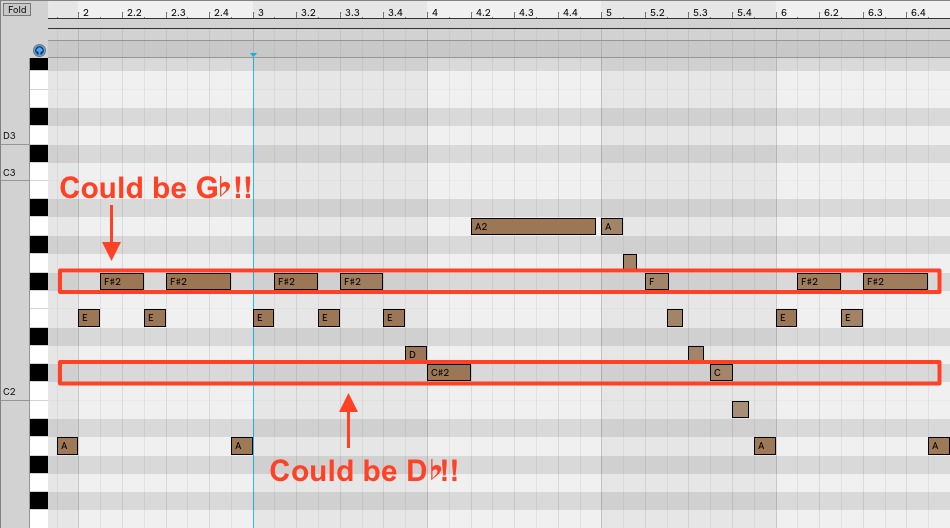Contents
1. Circle of Fifths
As explained in the previous section, Any key other than C major or A minor need to involve black keys to construct the correct step structure. But manually measuring “WWSWWWS” is cumbersome.
So music theory, surprisingly, offers an official cheat sheet for this!
This is called Circle of Fifths. It was named so because the clockwise progression of C → G → D → A… is advancing exactly by the interval of fifths each time.
OK let me explain. You have 12 tones (7 white keys, 5 black keys) and the Circle of Fifths arranges them a la clock. The order of alphabets may look odd but you’ll see. It is like a disc-shaped music encyclopedia that gives us a variety of practical information for songwriting.
2. How to Use
Typical use of Circle of Fifths is to look up the correspondence between a key and a key signature. For example, look at the area in the “3 o’clock” direction🕒
Here are the score with 3 sharps(at F,C,G), the sign “A” and “F♯m”, each of which means…
- A; stands for “A major key”
- F♯m; stands for “F♯ minor key”
- The score with 3 sharps is the key signature for the keys above.
Say you’re a track maker, and put some loops with key info “F♯m” in their file names…

…Then you feel like adding some MIDI phrase on it. Which notes will be candidates? —Now refer to Circle of Fifths. You can see that F, C, G should be sharpened (basically). With the help of Circle of Fifths, you don’t need to count the steps like “WSWWSWW”!
To get familiar with it, let me take another example. Imagine you’re a musician and told by someone “This song is in A♭ major key. Can you play some solo on it?”—Then search for the sign “A♭” in Circle of Fifths. It’s in the 8 o’clock direction🕗
From the score you can see that B, E, A, D should be flattened.
3. Judging the Key of a Song
Now that you’ve finally got this great tool, let’s practice judging the key of a song you make! There could be a situation where you first come up with a melody and try to add loop audios to complete songwriting.
Making a melody is done. But how can you find the samples that fits best to it?—Yes, Circle of Fifths. First of all, you have to check which black keys are used. And it’s ideal if you can detect which pitch acts as tonal center.
This is the piano roll for the melody. You can see that F and C are sharpened. In this process you have to check whether it is sharpened or flattened, because most DAWs always label black keys as sharp.
But in this case, they must be F♯ and C♯ for following reasons.
- Natural G and D appear in the line. coexistence of natural pitches and flattened pitches is rare.
- Looking at Circle of Fifths, you can’t find any key where only G and D are flattened.
Suppose that they’re F♯ and C♯, a certain “search result” comes up from Circle of Fifths—D major / B minor key, in the 2 o’clock direction🕑
It’s the more convincing if you can feel D or B as tonal center. D major key / B minor key are relative keys so you don’t necessarily have to specify which of the two keys the song belongs to.
Now you can add phrases in harmony, whether loop or MIDI!
Success is Not Guaranteed
However, depending on songs, the scale may change temporarily, or a song may not be based on Western scales in the first place. Keep in mind that you might fail to judge the correct key with this method. After all, knowledge of chords is required to analyze a song perfectly. That said, this “encyclopedia” does help you in many situations.
Non Musical Sheet Version
For those who are not familiar with musical notation, I made another version where musical score is replaced with keyboards!
Circle of Fifths will be utilized also in memorizing knowledge in Chord Theory domain. So you’ll see it again in “Chord” part as well. I recommend that you print this and pin it to the wall in your room, seriously!
Depending on texts, its design is horizontally flipped, or differently named like “Cycle of Fifth”, “Circle of Fourth” or “Circle of Keys”, but essentially there’s no difference.
Circle of Fifths has been used for over hundreds of years1……Yeah, I don’t like memorization. Neither you do. People centuries ago too😎
Easing the pain of memorization in early learning stages is a key to avoid the frustration of tedious study so please make use of it and enjoy learning music theory♡
Summary
- Circle of Fifths is a figure that summarizes all the key signatures.
- You can see the correspondence between key signature and keys through it.
- Circle of Fifths has more features that has yet to be explained.



